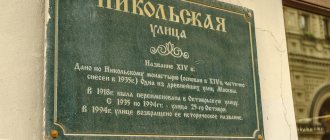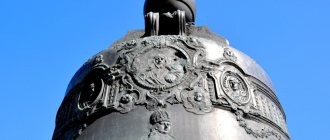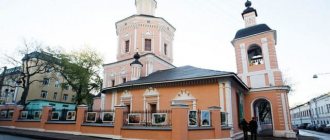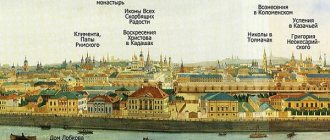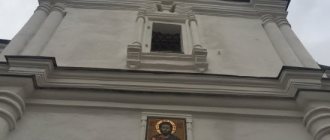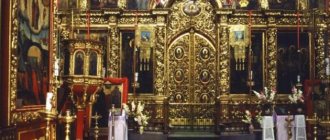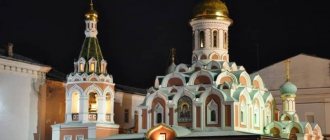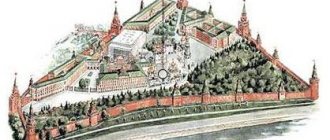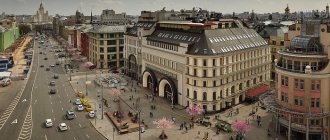Church of St. John Climacus
The foundation of the bell tower was laid on the site of a building that existed in the 14th and 15th centuries. Church of St. John the Climacus. The ancient church was built specifically for bells. In appearance, it resembled ancient Armenian cathedrals. The internal space was divided into parts crosswise. From the outside, the building had the shape of an octagon.
The altar part was located in a semicircular apse, oriented to the east. A place was allocated for the bells on the 2nd tier of the church. The square adjacent to the cathedral was dubbed Ivanovskaya. The tsar’s decrees were proclaimed there and other important state documents were read. The heralds had to shout loudly, “at the top of Ivanovo.” At the beginning of the 16th century, it was decided to dismantle the Church of St. John the Climacus, and in its place to build a bell tower, in memory of the deceased Moscow prince Ivan III “The Great”.
Construction of the Assumption Belfry
The Assumption Belfry was built near the bell tower in the 16th century. Initially, the Italian architect Petrok Maloy erected the Church of the Nativity of Christ next to St. John's Pillar, but later the temple was reconstructed into a belfry for large bells.
The largest bell is called Uspensky, which is why the belfry was named in his honor. Previously, watchmen and bell ringers lived right in the belfry building, on the first floor. Now one of the Kremlin museums is located there.
The inscription under the dome of the Bell Tower of Ivan the Great
The relics of Nicholas the Wonderworker and the miraculous icon of St. Nicholas were kept in the Church of the Nativity of Christ. During the reconstruction, the Shrines were taken out of the temple; their location is still unknown.
Interesting to know! Despite the fact that the Church of the Nativity of Christ was reconstructed and the miraculous icon disappeared, the custom of coming to the belfry for a blessing before the wedding has still been preserved.
As the legend goes, one impoverished townsman married off his three daughters, turning to St. Nicholas the Wonderworker for help. Saint Nicholas gave each girl a bundle of gold as a dowry. Since then, many newlyweds visit the Assumption Belfry to ensure a strong marriage.
History of the construction of the Bell Tower
Foreign architects were invited to supervise the construction, which was unprecedented in Rus' in terms of the height of the structure. The project was headed by a native of the Apennine Peninsula, architect Bon Fryazin. The work lasted 3 years (1505-1508). To ensure reliable fastening of the tower, Fryazin ordered oak piles to be driven into its base. Oak wood, under the influence of groundwater, acquires enormous strength and reliably holds the entire structure. In this case, the depth of the foundation is no more than 4.3-4.5 meters.
In addition, the architect skillfully used other methods of stabilizing the structure:
- metal fasteners inside brick walls;
- adding eggs to the binding solution;
- thick walls of the lower tier (up to 5 m).
Initially, the plan provided for the creation of a 2-tier building. However, in 1532 they decided to expand the architectural ensemble to include the Church of the Resurrection and the bell tower. The construction work was entrusted to the Italian Peter Francesco Anibale, known in Rus' under the nickname Petrok Malaya Fryazin. He added a third tier to the tower, on which a giant bell weighing approx. 1.5 t. The giant had his own name “Blagovestnik”. To climb up, a ladder was made inside the walls.
The total height of the tower was 81 m. It acquired strategic importance, since from the upper platform the outskirts of the capital were visible far away (at a distance of 30-40 km). To prevent the view from being blocked, by order of Boris Godunov, it was forbidden to erect buildings in Moscow larger than the Ivan the Great Bell Tower. The upper decorative superstructure was surrounded by gilded letters. The inscription says that the work on the improvement of the temple was carried out according to the order of Boris Godunov and his son Fyodor.
The first tsar of the Romanov dynasty, Mikhail Fedorovich, ordered the conversion of the Resurrection Church into the Assumption Belfry. An outbuilding was also added to the temple, which began to be called after Patriarch Filaret.
In its completed form, the architectural ensemble combines 3 parts:
- 8-sided tower-shaped bell tower
- church with a belfry in the Pskov-Novgorod style
- outbuilding with hipped roof
Despite its height, the bell tower visually appears light and slender. A similar effect is achieved by gradually narrowing the tiers. The upper part ends with a rounded drum, above which rises an onion-shaped gilded dome. Stone kokoshniks with pseudo-window openings serve as decorative architectural elements.
Various building materials were used in the construction of the building:
- white hewn stone – foundation and plinth
- red brick – the main part of the structure
The fate of the Church of Ivan the Great during the war with Napoleon
After the capture of the Russian capital by Napoleonic troops, the bell tower became the headquarters of General Lauriston. During the retreat, the French mined and blew up the Kremlin. The Filaretovskaya extension and the Assumption Belfry were completely destroyed. The bell tower remained standing, but a huge crack ran along the upper tier.
The gilded cross on top of the dome of Ivan the Great was considered by Muscovites to be a symbol of royal power. That's why Bonaparte ordered it to be removed. When the French soldiers found out that the product was based on a copper alloy, and not precious metals, they threw the remains at the walls of the Assumption Cathedral. In place of the overthrown cross, a new one was erected, made of iron and covered with gilded copper plates. Its top crossbar was decorated with the inscription “King of Glory.”
Post-war restoration work was led by the Swiss architect Domenico Gilardi. He was guided by a project drawn up by the architect Luigi Ruschi. During the renovation, white facing stone was used, and the decor on the top of the bell towers was modified. The main innovation was the relocation of the dome of the Assumption Belfry to the western part of the roof.
Bell tower during the Great Patriotic War
Immediately after the outbreak of hostilities in the summer of 1941, a command post for a military department located on the territory of the Kremlin was organized in the building. It operated from June to September 1941. To establish uninterrupted communication inside the Tsar Bell, at the foot of the belfry, a communication center was equipped.
Restoration of destroyed buildings in the post-war period
At the beginning of the 21st century. Specialists were involved in the reconstruction of the architectural ensemble. During the work, they discovered fragments of an ancient floor (18th century). A new coating was laid according to his sample.
The method of fragmentary restoration was also used to preserve the original appearance of the interior staircase, doorway, and decorative elements (rosettes, cornices, imposts) inside the room. The work carried out made it possible to leave intact and demonstrate to visitors original examples of ancient Russian architecture.
History of the bell tower
The history of Ivanovsky Pillar is directly related to the formation of the Russian state.
Church of John Climacus
The Monk John Climacus was a Byzantine theologian, the author of the doctrine of spiritual rebirth and the treatise “The Ladder.” It was in honor of this saint that a church was erected by order of the Moscow prince Ivan Kalita in 1329.
There is a version that the temple was built according to a vow that Kalita made before the Moscow squad’s campaign against Pskov. Luck was with Ivan Danilovich, and he kept his vow.
So in just three months the Church of St. John the Climacus appeared. It had the shape of an octagon with semi-columns at the corners.
The internal cruciform space of the Church of St. John the Climacus, excluding the altar room, was small in size - only five by five meters.
The Church of St. John the Climacus in the Moscow Kremlin stood for more than 170 years, was dismantled in 1505, but took its place in history as the first stone church known to researchers under the bell, the first pillar-shaped church-bell tower and the first temple built between two cathedrals.
Construction and foundation of the bell tower
The Church of Ivan the Great had no shortage of talented architects. Therefore, answering the question of who built it is quite difficult.
When the old temple was dismantled at the beginning of the sixteenth century, a new church was erected on the eastern side. Who is it named after? The name of the temple was given by Ivan III.
The construction was supervised by the Italian architect Bon Fryazin. He completed his masterpiece in 1508.
The building had no analogues in terms of strength thanks to its unique foundation and construction methods that were revolutionary at that time.
The author of the next project, which changed the appearance of the temple in 1540, was also an Italian - Petrok Maloy. He built a rectangular belfry on the north side of the building.
In 1600, under Boris Godunov, the now Russian architect Fyodor Kon built the third tier of the bell tower. The height of the Ivan the Great Bell Tower in Moscow is 81 meters.
There is a metropolitan legend about the ban on the construction of bell towers higher than the belfry of Ivan III. Until 1860, when the Cathedral of Christ the Savior was built, the bell tower remained the tallest building in Moscow.
Historical fate
The temple had to go through many trials.
Troubled times, invasions of foreign conquerors and the political ambitions of domestic atheists more than once threatened the very existence of the pillar of Ivan III:
- False Dmitry was going to build a church there for the Polish subjects of Marina Mniszech.
- Napoleon ordered the Kremlin to be blown up. This decision became fatal. The explosions turned the Assumption Belfry and Filaret's annex into ruins, tore the cross from the dome of the bell tower, and led to the formation of a crack on the third tier. However, the bell tower itself survived. Already on December 12, 1813, the bells of the pillar of Ivan III were sung again, inviting Muscovites to a church service.
- There is a legend that in the 1950s or 1960s, someone tried to break the ban on ringing bells, after which their tongues were chained.
- Soviet leaders silenced the belfry for seventy-five years.
It was not until Easter 1992 that the bells began to ring again.
Assumption Belfry and Filaretovskaya Annex
In 1624, the architect Ogurtsov created the Filaret extension, named in honor of Patriarch Filaret.
The architect of the extension's tent was the Englishman Thaler, who worked during the reign of Alexei Mikhailovich.
By the end of the 17th century, the belfry became one of the symbols of Moscow.
From the bell tower there was a magnificent view of the surrounding area, and the approach of enemy troops could be seen 30 (!) kilometers away.
The building of the Assumption Bell Tower, attached to the northern edge of the bell tower, was erected in 1815 on the foundation of an old building of the 16th century destroyed in 1812.
These structures became an integral part of the bell tower.
Post-war restoration
Large-scale reconstructions of the bell tower were always hampered by something: wars and post-war devastation, lack of financial resources, disputes between architects. However, the Filaretovskaya extension and belfry, destroyed by the French, were rebuilt in 1819.
The first serious restoration took place in 2005.
The craftsmen carried out a complete re-equipment and adapted the ancient structure for museum use, and prepared the facades and external interiors of the bell tower for museum display.
Current situation
Nowadays, the architectural object is used both for its intended purpose and as a museum exhibition.
Today, on the ground floor of the Assumption Belfry, exhibitions of the Moscow Kremlin Museum and other Russian and foreign museum collections are organized.
To complete the picture, visitors are shown a video projection of the reconstruction of the cathedral, using the whitewashed walls of the bell tower.
Periodically, all projections are turned off, leaving only the backlight, and visitors have the opportunity to examine the preserved interiors of the bell tower.
Conventionally, this museum can be divided into three exhibitions: the bell tower itself or its parts highlighted by light, preserved fragments of Kremlin buildings and virtual exhibits.
There is an observation deck on the top tier of the bell tower.
Visitors can climb it in the warm season, covering a path of 329 steps.
About the bells
In total, there are 34 bells in the belfry. Among them are foundry products of masters of the 16th-19th centuries. The best alarm bells in Russia were cast in Moscow. The most famous bells had their own names. It was customary to decorate them with bas-reliefs and ornaments. A commemorative inscription was left on each bell indicating the name of the master, date of manufacture, and weight.
The starting materials were a special “bell” alloy. It included:
- copper
- tin
- silver
- gold
The proportions of metals were set by the master. The sound of the ringing largely depended on the content of the composition. Over time, the bells lost their ringing quality, cracks formed in the walls, and the product was sent for melting down. Wooden beams were initially used to secure the bells on Ivan the Great. In the 19th century, they began to be gradually replaced by more durable metal ones.
Assumption Bell
The authors of the Festive or Assumption Bell are Russian masters Zavyalov and Rusinov. The alarm is characterized by a strong clear sound. This is the most powerful bell in the belfry. Its mass is 65,320 kg.
Bell Howler
The second largest bell on Ivan the Great is considered to be Revun or Reut. It is 2 times smaller than its brother - 32,760 kg. At the same time, this is the alarm - the patriarch. It was made in 1622 by the famous Russian foundry maker Andrei Chokhov.
Seven hundred bell
The Everyday or Seven Hundred Bell was intended for daily use. It is noticeably inferior to its loud comrades and weighs 13071 kg. The creator of the alarm is I. Motorin.
Other bells
Depending on the range of sounds produced, bells are divided into 3 types:
- ringing - treble
- red
- good news - bass
The combination of different sounds creates an overall harmonious chime. Therefore, a whole orchestra of alarm bells was placed on the bell tower. They were distributed over 3 tiers of the tower:
- On the bottom - Swan, Bear, Shirokiy, Novgorodsky, Rostovsky, Slobodskoy.
- On the middle - Korsunskie (3 pcs.), Novy, Nemchin, Bezymyanny, Danilovskiy, Maryinskiy, Glukhoy.
- On the top – Nameless (3 pcs.).
After the establishment of Soviet power, bell ringing was banned. In 1992, the chime on Ivan the Great sounded again.
Bells
The Ivanovo Bell Tower serves all the Kremlin cathedrals, since they do not have their own belfries. It is from here that the ringing of bells throughout Moscow begins.
Interesting to know! Metropolitan Plato in the 18th century issued a decree according to which the ringing of bells in the capital was to begin with the strike of the largest bell, after which it smoothly spread throughout the city, filling with the shimmer of other bells. This made the sound especially beautiful and solemn.
Central tier
- The largest bell is the Uspensky bell, it weighs over 60 tons. It was cast in 1819, replacing the bell that was broken when St. John's Pillar was blown up during Napoleon's invasion. The bell depicts the faces of Christ and the Virgin Mary, and there are images of members of the royal family. At the bottom of the bell there is a memorial inscription in honor of the liberation struggle of 1812. The bell rings only in exceptional cases.
The main tier of the bell tower of Ivan the Great - The second largest bell is Reut. During the explosion of the bell tower, it fell, but did not split, so it was restored. The sound of the bell is unusual, low, and sets off the ringing of other bells, making the bell ringing more intense. The weight of the bell is about 30 tons.
Interesting to know! People call this bell “Howler”. On the day when Alexander II ascended the throne, the bell fell off and killed several bell ringers. People considered this a bad sign. After several assassination attempts, Alexander II died at the hands of terrorists.
- The seven hundredth bell was cast in the 18th century. His blows herald the beginning of Lent.
Lower tier
- The Novgorod bell was taken by Ivan the Terrible from the conquered Novgorod;
- The Swan Bell has a sharp, high-pitched sound;
- The Bear Bell, on the other hand, makes a low, roaring sound;
- In addition, the bell tower also contains the Slobodskoy, Rostov and Trekhsotpudovy bells.
Middle tier
In the middle tier of the bell tower there are:
- Mariinsky bell with the image of Mary of Egypt;
- Danilovsky bell with the face of Prince Daniil of Moscow;
- 8 bells, the manufacture of which dates back to the 16th century.
Upper tier
The upper tier is represented by several light bells from the 17th century.
Bell Tower Museums
The room inside the Assumption Belfry has been converted into a museum. It contains ancient artifacts, with the help of which the history of the arrangement of the Moscow Kremlin is clearly presented. In the museum collection, visitors can see fragments of existing and already disappeared buildings on the territory of the capital’s Detinets.
The exhibition hall serves as a location for traveling exhibitions. Selections on the following topics were shown here:
- “Tsar weddings and coronations in the Moscow Kremlin”
- “The art of preserving art. Restoration at the Moscow Kremlin Museums"
- "The Golden Age of the English Court: From Henry VIII to Charles I"
- "India. Jewels that conquered the world"
Bell tower of Ivan the Great today
In addition to being an object for tourists to visit, the belfry fulfills its main purpose. Its bells sounded again after an almost 75-year break, in honor of the Easter holidays in 1992. It is on the Ivan the Great Tower that the bells are the first to ring on the days of the main church holidays.
Before the bells started working again, they were examined. The huge Festive bell is rung less often than others. Because it requires several ringers to work with it. The weight of the bell tongue is 2 thousand kg. On the upper tier, located at an altitude of 80 m, there is an observation deck. Visitors can climb it in the warm season. However, the path of 329 steps must be covered on foot.
Architects
At different times, different people worked on the construction, repair and reconstruction of the bell tower, so it cannot be said that this majestic structure is the fruit of the labor of one architect.
- When the bell tower was erected on the site of the old temple, the construction was supervised by Bon Fryazin;
- Petrok Maloy completed the belfry on the north side of the bell tower;
- Russian architect Fyodor Kon supervised the construction of the upper tier of Ivan the Great under Boris Godunov;
- The restoration of destroyed buildings after the War of 1812 was carried out by Domenico Gilardi and Constantin Ton.
Bell tower of Ivan the Great Moscow Kremlin on the map
- Sights of Florence
- Sights of The Hague
- 10 best resorts in Abkhazia for families with children
- 5 star hotels in Mallorca with private beach
- Visa to Australia on your own
- The Bridge of Sighs in Venice - a romantic place with a dark past
- Tours to Phuket for 10-11 nights, 3 and 4* hotels with breakfast from 77,870 rubles for TWO – March, April
- Tours to Cuba, 10-11 nights, 3-5* hotels, all inclusive from RUB 106,671 for TWO – June
- 4 star hotels in Goa near the beach
- How to get to Krabi
- The Colosseum in Rome is the most majestic arena
- Anapa hotels by the sea
+2
